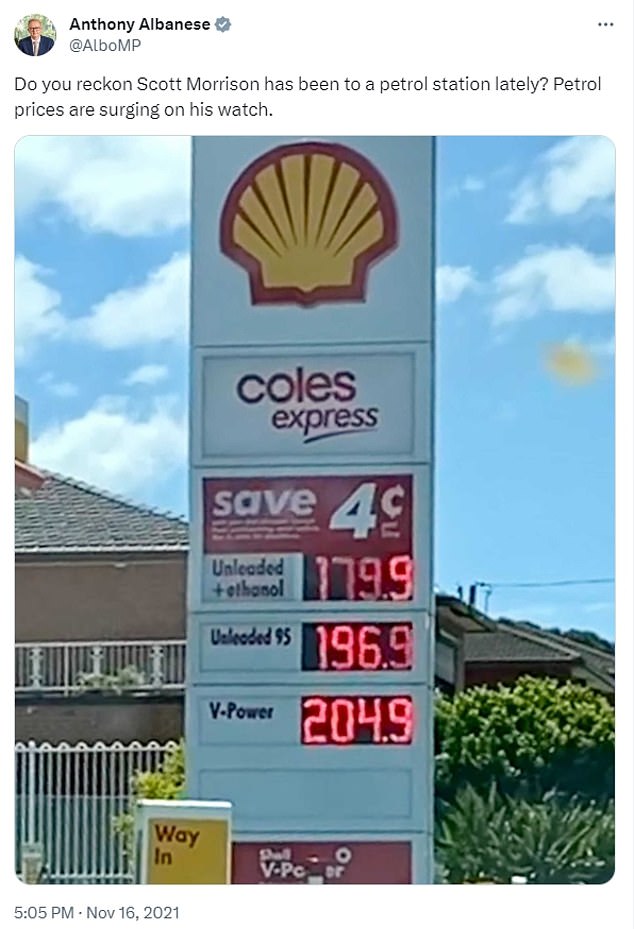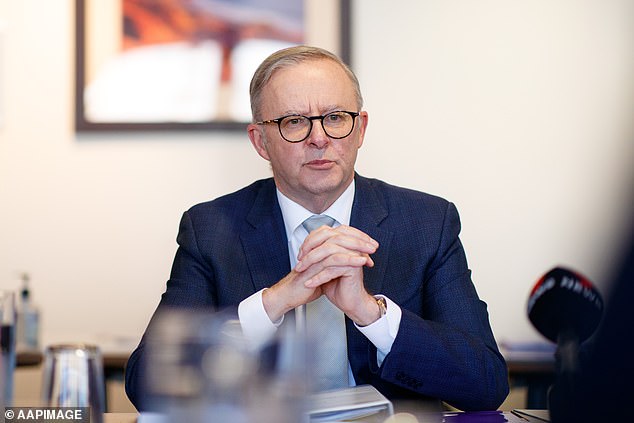Petrol prices: Anthony Albanese tweet mocking then-PM Scott Morrison comes to haunt him as fuel costs skyrocket
A social media post in which Anthony Albanese attacked Scott Morrison over high fuel costs has resurfaced as petrol prices at the pump soar to record highs.
Petrol prices in Brisbane hit an all-time high on Wednesday, with some retailers charging $2.38 per litre, according to the Australasian Convenience and Petroleum Marketers Association.
Drivers in Sydney and Melbourne are currently paying as much as $2.29 per liter but have been warned of further spikes as cuts to global oil supplies coincide with travelers hitting the road during the school holidays.
In November 2021, Mr Albanese posted on Twitter the question: ‘Do you think Scott Morrison has been to a gas station lately? Gasoline prices are rising on his watch.”
He accompanied the comment with a photo of a Shell gas station selling unleaded for $1.96 per liter – well below current prices.
Fuel prices have reached astronomical levels in major Australian cities due to a global shortage and an increase in consumer demand (photo: a servo from Sydney last month)

In 2021, Anthony Albanese took a smug swipe at then Prime Minister Scott Morrison over petrol prices, which were significantly lower than they are now
One Nation leader Pauline Hanson took to
The photo shared by Senator Hanson showed unleaded E10 selling for $2.35 and unleaded E10 selling for a whopping $2.54.
According to official government figures, the price of car fuel increased by 13.9 percent between August 2022 and 2023, pushing up transport costs by 7.4 percent.
Commentators on Senator Hanson’s post are outraged by soaring fuel prices, which are largely responsible for a rise in the Consumer Price Index (CPI), the measure of inflation.
The CPI for August was 5.2 percent annualized, compared with 4.9 percent in July, raising concerns that the Reserve Bank may consider another rate hike.
‘Scandalous! I don’t care what people have to deal with. At least Morrison was kind enough to cut fuel duty,” said one Aussie.
“Please do something, my life on the road is getting expensive,” said another.
“What a shame for Albo that this continues to haunt him,” a third added.
“He wouldn’t know because he would be transported in a government vehicle fueled at taxpayer expense,” a fourth added.
Earlier this month, the Prime Minister was asked about basic costs in the wake of a major speech at the ALP National Conference, where he said the cost of living was the first priority for his government.
‘Can you tell me approximately what the price of petrol is at the moment?’ asked Sky News presenter Andrew Clennell.
‘Well, I’m not going to fill up my car. But last time it was about $1.80,” the Prime Minister replied.

One Nation leader Pauline Hanson took to Twitter to address Mr Albanese’s comments

Mr Albanese said earlier this month that the price of petrol was about $1.80 the last time he filled up a car
Compare the Market’s Chris Ford told The Guardian there was an unusually high difference of 44c between the most expensive and cheapest fuel in Brisbane on Wednesday.
He wondered how much of the record high price was driven by oil prices and supply, and how much by companies needing to make a buck on the weekly gasoline cycle.
“What we’re seeing is that the expensive sites tend to cluster,” he said.
“So one site will jump and then the adjacent sites will jump, and then over the course of those ten days those expensive clusters will grow and the cheap clusters will shrink.”
“If you were to fill a 50-gallon tank, you would save $20 by filling up at the cheapest location instead of the most expensive.”
KPMG chief economist Brendan Rynne said international oil prices were driven higher by a decision by the Saudi-led Organization of the Petroleum Exporting Countries (OPEC) to agree with Russia to restrict oil supplies.
Russia and Saudi Arabia are limiting their production of 1.3 million barrels of oil per day, despite rising global oil demand.
